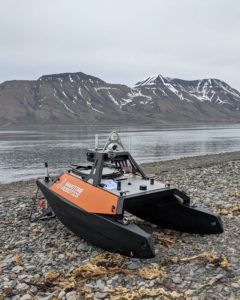Climate change in Arctic coastal systems leads to declining sea-ice and sea-terminating glaciers, and these changes are expected to modify biodiversity and ecosystem functioning in the littoral fjord areas in Svalbard. In addition, influx of Atlantic water and invasive species, which may compete with and displace Arctic species, may change community composition and spatial distribution. This study aims to contribute to a better understanding of the links between marine biodiversity, land influx and changes in the cryosphere, addressing the ongoing climate change mechanisms in the High Arctic land to sea interactions.
Project description:
 As part of the EU project FACE-IT, this study aims to map the bathymetry,nutrients, temperature and salinity of littoral areas, and link them to the spatial distribution of biodiversity and abundance, with a focus on macroalgae communities and littoral fish distribution. The main research site in Billefjorden is characterized by both Arctic and Atlantic water, as well as a surface layer with sea-ice, high freshwater input from rivers and sea-terminating glaciers. The Billefjorden sites are compared to the more Atlantic water influenced system of Isfjorden. In the study, we use an Unmanned Surface Vehicle (USV) with an autonomous echosounder system, CTD measurements and image analysis, validated with transect samplings of macroalgae and marine fauna.
As part of the EU project FACE-IT, this study aims to map the bathymetry,nutrients, temperature and salinity of littoral areas, and link them to the spatial distribution of biodiversity and abundance, with a focus on macroalgae communities and littoral fish distribution. The main research site in Billefjorden is characterized by both Arctic and Atlantic water, as well as a surface layer with sea-ice, high freshwater input from rivers and sea-terminating glaciers. The Billefjorden sites are compared to the more Atlantic water influenced system of Isfjorden. In the study, we use an Unmanned Surface Vehicle (USV) with an autonomous echosounder system, CTD measurements and image analysis, validated with transect samplings of macroalgae and marine fauna.
The project involves:
Mainly fieldwork and potentially some lab and computer work. The methods that will be used are the USV, single-beam echosounder, drop camera, baited remote underwater video system (BRUV), CTD with turbidity, Photosynthetically Active Radiation (PAR) sensor, Nutrient analysis, and in-situ sampling of macroalgae and fish.
Starting date/period:
From 9 August – to the end of September
Prerequisites:
Basic knowledge in marine ecology and macroalgae/fish identification is desirable, but not required. Fieldwork will include long days at sea, so the student must be able to handle sea-sickness well. Fieldwork will involve deploying heavy equipment, so the student needs to be fit enough to lift somewhat heavy loads. Driving license also desirable but not required.
Interest and enthusiasm are the keys!
Experience/skills to be acquired:
The student will gain training in using a wide range of scientific methods (mentioned above) in the field, for monitoring of environmental marine conditions and sampling for macroalgae and fish. The student will also gain experience in doing Arctic marine research in the field.
Involvement:
Flexible (max 40h).The student will participate in most of the project fieldwork, both in Billefjorden and in Bjørndalen, and the post-processing later at UNIS. This will sometimes involve long days at sea, and the amount of work may vary between 1-3 days per week.
Most of the work will take place in August, but it may stretch well into September.
Interested by this project? Need more info? Contact:
Victor Gonzalez Triginer
Project number: 18
